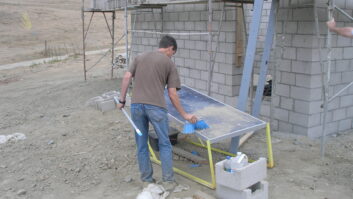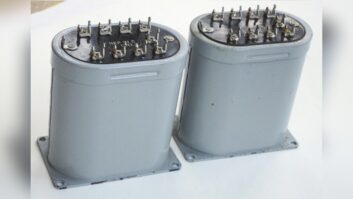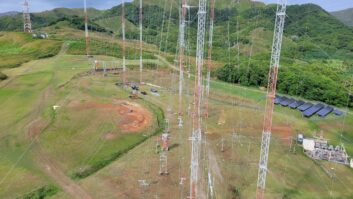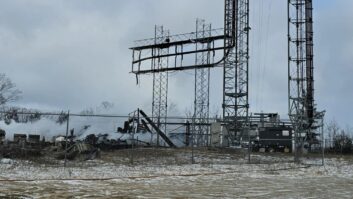WILQ rebuilds transmitter site
Aug 1, 2009 12:00 PM, By Tom Atkins
A joy ride becomes a prolonged project for WILQ.
On Oct. 9, 2008, I received a voice mail from Engineer Brian Hill and General Manager Dan Farr from WILQ in Williamsport, PA. I could tell by the level of shock and frustration in their voices asking me to phone them right away, that this was no ordinary problem.

What caused the damage? This log skidder.
�Tom, I was woken up at 4:30 this morning from the alarm company telling me there was unauthorized entries in the front door and all the windows at the WILQ transmitter site. When I arrived at the site, there was a log skidder, a vehicle primarily used in the logging industry, parked in the building where the front door used to be�. My response was �WHAT THE � ?! Was anybody hurt?� Fortunately, no one was hurt, and the joy riders were nowhere to be found. The building, on the other hand, was a different story.
In the wee hours of the morning the logging truck was hot-wired and then taken for a ride on top of Bald Eagle Mountain, the location of WILQ’s transmitter site. The driver had stopped in front of WILQ’s transmitter building, swung the truck around 90 degrees, and proceeded to drive the truck straight through the front of the building using the front door as a target. The truck appeared to have stalled in its final resting place, inside our transmitter building. To everyone’s amazement, WILQ remained on the air operating from this newly condemned building.
Because the structure was deemed unsafe, and there really was no way to secure it, the decision was made to have WILQ operate from its auxiliary transmitter site down the road. Power and other utilities would then be turned off at the main site.
First to the backup
The auxiliary site consists of a 1kW solid-state transmitter with a frequency-agile exciter feeding a single-bay antenna all manufactured by Armstrong. This would equate to roughly 10 percent of the station’s licensed ERP. However, the height advantage of being on top of a mountain paid off as coverage in the metro of Williamsport was adequate. Or let me put it another way, it sure beat hearing static on WILQ’s frequency of 105.1MHz for an unspecified length of time. When operation ceased from the main building, the process of shoring up the damage and somehow securing the building, at least from the elements, was the next concern.
A local general contractor was hired and he installed temporary supports so the building would not come down on its own accord. Small equipment in the building that was not damaged was carried out and stored to be later tested and inspected. The building was wrapped in plastic to keep out the outdoor elements, or at least most of them, and the chain link fence was temporarily put back in place as best it could. The real fun would come when we tried to extract the transmitters from the structure.
WILQ rebuilds transmitter site
Aug 1, 2009 12:00 PM, By Tom Atkins
A joy ride becomes a prolonged project for WILQ.
Temporary facilities
If you’re in tune with the survey period of Arbitron ratings you have probably realized that at the time of the destruction the important fall survey was underway, and 10 percent power would create a hardship, not only to the station, but to the loyal listeners of WILQ who live outside the coverage of the auxiliary site. They now could not receive the station. We decided to put all our efforts into erecting a temporary transmitter shelter that could be placed on the property away from the existing building. The tower and antenna were not harmed so it was conceivable we could get back up to full power from the main site. The big problem we had was that the current transmitters were still trapped in the old building and it would be a while before any attempt at removing them could be made. While the search for a temporary building was on, contacts were made to the various transmitter manufacturers to find out who had the shortest lead time on delivery.

The lonely Harris transmitter with the rolling rack inside the temporary shed.
We decided that a wooden, garden-variety storage shed was going to be the best solution for a temporary building. The advantage was that it could be delivered and put in place quickly, and with fall heading into winter, heat was not a big concern. It was also economical. In about five days, we had a temporary building on premise, and we hired a local electrician to install 200A single-phase service in the shed. On Oct. 15, we placed an order with Harris for a Z 5CD 5kW solid-state transmitter.
The word temporary is defined in the dictionary as not permanent. That is the way we envisioned the assembling of the temporary transmitter facility for WILQ: Temporary but reliable. Knowing this, there were some corners cut on purpose. Transmission lines and power for the tower lights were routed through a window in the shed rather than a nice entry bulk head. Grounding was accomplished with wire rather than copper strap. Interconnect wiring was not run as neatly as I would do in a permanent installation. We even used an old Tascam reel-to-reel roll around back to mount the STL receiver and Burk ARC-16 remote control. Safety, on the other hand, was kept as a high priority in addition to making sure the 220V service had a surge suppressor on it. On the morning of Oct. 23, the Harris Z 5CD arrived on a dedicated driver truck and was put in place in the temporary shed. Connections were made to it in the shed and on the afternoon of Oct. 24, WILQ was back to full power, 17 days after the destruction of the main transmitter building. An EPM was performed to verify that WILQ was operating within its instrument of authorization.
Demolition
Demolition of the existing main building was next on the list. No, we did not forget about the transmitters still inside the old building. After reviewing many possible ways to remove the transmitters, it was determined that the safest for working personnel and the equipment was to box the transmitters and Onan power generator in a protective housing and demolish the building around the equipment. Once the building was down and the debris removed, the transmitters, still in their crates, were removed from the site and transported off the mountain into a storage facility in the valley. While there, they were connected to power and a dummy load and tested in January 2009. To everyone’s surprise, both the Harris HT-5 and the Gates 2.5KW worked. We were very skeptical of this given the debris inside the transmitters and the fact that they were subjected to extreme temperature differential for almost a month, not to mention that they sat idle for almost three months.
WILQ rebuilds transmitter site
Aug 1, 2009 12:00 PM, By Tom Atkins
A joy ride becomes a prolonged project for WILQ.
The new building
With WILQ operating at full power from the temporary shed, and everything except the Onan power generator removed from the remaining concrete pad, construction of the new building was ready to take place. We discussed, at length, the best way to proceed. There were precast buildings available, which I am a big fan of, however, we ran into a couple of obstacles for a precast. One was the winding road leading up to our mountain site and two, our site sits on land that is owned by the Forestry Department, from whom we lease. The winding road bore tales of other communication companies trying to maneuver a flat bed truck carrying a precast building and dumping its load. Taking a look at the paved road and a couple of the hairpin curves on it, I thought a skilled driver may be able to make it, but we really didn’t have the time nor the stomach to risk losing a precast building. Doing this in November in Pennsylvania only added to the fire. Or should I say snow? Besides, if we did actually get a precast building to our site, we would have to renegotiate our lease with the Forestry Department as we would be making a major change. We made the decision to build a cinder block building on the remaining concrete pad exactly the same size as the old one.

Near completion, the new building sat empty for several weeks before equipment could be moved in.
The opportunity to build a fresh building has some advantages. Considering the old one was built in the late 1940s, we had the pleasure of constructing something a little more modern. We did not need four small rooms on the footprint of the building, but rather a small room to house the power generator and one large room for the equipment and workbench. The plans were drawn to accommodate the new design. Working with a local architect, we also decided to insulate the building and put a pitched roof on it with concrete pavers lining the top for ice protection. We also agreed to not install any windows.
A long time ago, a wise old engineer once told me that if you keep the transmitters cool and clean they work forever. Keeping with that tradition, cooling and cleanliness were of top priority. Because the site is on top of a mountain subjected to the Northeastern climate and being only a 5kW TPO, air conditioning was really not needed. The transmitters would vent into the room and a thermostatically controlled 36″ exhaust fan would remove any additional heat. The fan would also have gravity-controlled louvers that would close when not running. Clean air intake from the outside was accomplished through a 36″ opening on the opposite end of the building. The air intake would have two special requirements. It needed to have a filter box to filter incoming air from any dust, dirt or small insects. It also required a motorized damper that would open when the exhaust fan would turn on. One very important aspect of the motorized louvers is the ability for them to open upon removal of control voltage. The theory behind this is simple: If for some reason the motor or the electric controlling the damper motor fails, the louvers would open and not starve the building for fresh air. Even if a failure happens in the winter months, the heat from the transmitters would be sufficient to keep the building above freezing.

Everything installed and back on the air
The construction of the new building lasted until the second week of December 2008. When completed, mother nature decided to do what she normally does in winter in the Northeast. There the building sat with its walls and roof built protecting it from the elements. It did not have electricity or transmitting equipment. It would stay in that condition until February 2009 when we would start populating the building.
Moving in
In building the actual RF facility, we decided to lay out the footprint of the equipment with the future in mind. We did not want to box ourselves in with regards to future tenants or technological advances beckoning at our door. The facility would consist of the Harris Z 5CD, Harris HT-5 and an equipment rack. A wire ladder-rack system was installed above the transmitters and rack making a 90 degree turn toward the back wall of the building where the transmission line bulk head was installed. We were able to populate the RF facility with the Harris HT-5 and equipment rack while still operating from the temporary shed with the Harris Z 5CD. My assistant, Dan Gurzynski, would then proceed to plumb in the HT-5 and dummy load to the Dielectric antenna switch. He would also install the ground system consisting of 2″ copper strap.
WILQ rebuilds transmitter site
Aug 1, 2009 12:00 PM, By Tom Atkins
A joy ride becomes a prolonged project for WILQ.

The original transmitter building…
We purchased a Tunwall TRC-1 controller for the Dielectric antenna switch. It was at this point that Gurzynski would begin the cleaning of the HT-5 and subsequent testing into the Bird dummy load. Utility power was not available in the new building yet, but we did have the original Onan power generator and its new transfer switch installed along with all the rest of the ac power infrastructure. The generator was load tested to assure its reliability and it too came away from the destruction of the old building unscathed. It was this setup that afforded Gurzynski the ability to begin the testing.

…the temporary shed…
By March 2009 the pre-wiring effort to complete as much as we could proved advantageous when it came time to cut over to the new building. In keeping with this theme, we purchased a BDI analog composite DA and a new Armstrong X-Link STL receiver. This would leave only the transmission lines and the Burk ARC-16 remote control to be removed from the temporary shed and put into the new building. A relay panel for the ARC-16 was pre-wired in the new building to ease the move. We would then be operating on the HT-5 while movers transported the Z-5CD transmitter from the temporary shed to the new building at the end of May 2009. Considering that the spring 2009 rating survey would be well underway before we cut over, we wanted to reduce the amount of time we had to be on the auxiliary site down the road operating at 10 percent power.

…and the newly constructed building.
In the second week of June 2009, the Harris Z 5CD was finished being wired into the facility, tested and subsequently put on the air. Countless hours were poured into the reconstruction of the WILQ transmitting installation. Our plan was to rebuild it to be professional and reliable. It is now finished and thankfully this chapter in the history of Backyard Broadcasting’s WILQ is now closed.
Atkins is VP, director of engineering of Backyard Broadcasting, Buffalo, NY.
Equipment List
Armstrong X-Link
BDI CMP-300
Bird 5kW load
Burk ARC-16
Dielectric Model 50000
Harris HT-5, Z-5CD
Inovonics 531
LEA SP-200
Myat 1-5/8″ coax, couplings, field flanges, and 90-degree elbows
Onan 15kW genset
Onan/Cummins LT-200
Tunwall TRC-1
Xcel CPS A1/A2
WILQ rebuilds transmitter site
Aug 1, 2009 12:00 PM, By Tom Atkins
A joy ride becomes a prolonged project for WILQ.
Building damage:




The old building removed, construction of the new building can begin.

Weather during construction was less than ideal.

The building air intake…

…and exhaust.












